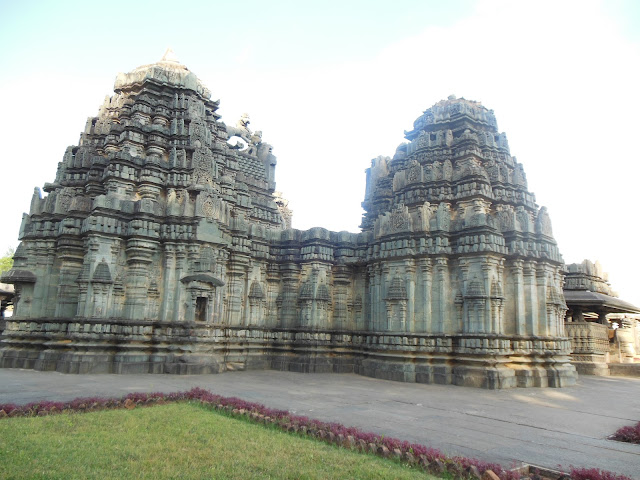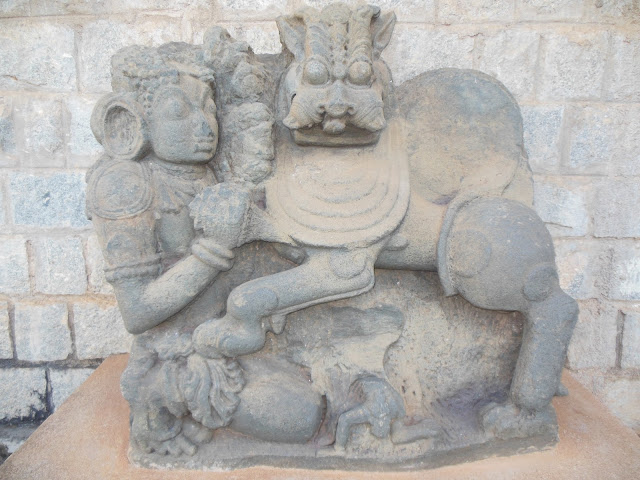Its ancient names are Dakshina Kedara,Valliggame and Valligrame. Dakshina Kedara means Kedarnath of the South. A place of antiquity, it is known for its ancient monuments. It is also famous as the birthplace of the great Virashaiva saint Allama Prabhu Balligavi is also the birthplace of Shantala Devi, queen of Hoysala king Vishnuvardhana. Many famous Hoysala sculptors like Dasoja, Malloja, Nadoja, Siddoja hailed from here. Today, Balligavi (Balli in Kannada means creeper or vine) is a quite town much of whose daily routines revolve around agriculture and the famous 11th century Kedaresvara Temple and Tripurantakesvara Temple.
Legend has it that Balligavi was the capital of a Asura king (demon) and hence was called Balipura (city of Bali). The Pandavas later arrived here while on their Vanavasa (forest dwell) and installed the Panchalinga (five lingas) and hence the name Panchalingeswara to the well known temple here. Linga is the universal symbol of Shiva. Archaeologically Balligavi dates from the Satavahana-Kadamba era and the Chaturmukha linga (four faced linga) here is in their style. The earliest inscription mentioning the name Balligavi is a 685 CE Badami Chalukya inscription.
The golden age of Balligavi was during the rule of the Western Chalukya Empire during the 10th-12th centuries. Balligavi during these times had six mathas, three puras "extensions", five vidyapithas "places of learning", and seven Brahmapuris. The mathas belonged to Shaivas, Vaishnavas, Jainas and Buddhists. The Kedareshwara matha belonging to the Kalamukha Shaivas and the Kodiya matha was well known and had the patronage of the Hoysala emperors, marking the place as one of religious activity. Records also indicate that an ancient University existed here.The town also had 54 temples and supported 60,000 residents during that time. Earlier to the Chalukyas, the area came under the Banavasi province of the Kadamba Dynasty. Important Kadamba inscriptions like the Talagunda inscriptions, near Balligavi.
Kedareshvara temple :
This is an excellent example of a trikuta "triple towers" temple in a transitional Western Chalukya-Hoysala architecture. It is the oldest example of such a combinational style in Karnataka according to reports from the Mysore archaeological department. The temple faces east and has a stepped entrance on three sides. The entrance on the sides is a Western Chalukya idiom. The central shrine has a linga (universal symbol of Shiva) made from black marble (Krishnashila). The shrine to the south has a linga called Brahma and the shrine to the north has a statue of Janardhana (Vishnu). The temples outside plan is in "staggered-square" style with many projections and recesses which is a Hoysala design.The outer walls of the open mandapa (hall) have carvings of women wearing fine jewellery. Two Hoysala emblems were added in 1060 CE by Hoysala Vinayaditya. The superstructure (tower) of the vimana are very well decorated with sculptures of Tandaveshwara, Varaha, Uma Narasimha, Bhairava etc. (avatars of Shiva and Vishnu) and the sukanasi of all three towers still exist. The western shrine is the oldest dating from the 7th or 8th century. Attached to the vestibule that connects the shrines is a well designed open mantapa with two rows of pillars. The outer row of pillars are 16 faced while the inner row of pillars are lathe turned with bell shaped mouldings, a style popular with both Western Chalukys and Hoysalas.The ceiling of the mantapa is flat and the inner ceiling is well carved with lotuses in them. The central ceiling has the carving of Tandaveshwara (dancing Shiva) with eight dikpalakas (guards). The entrance to the shrine which faces east has a Nandi, the bull and a celestial attendant of Shiva.
Legend has it that Balligavi was the capital of a Asura king (demon) and hence was called Balipura (city of Bali). The Pandavas later arrived here while on their Vanavasa (forest dwell) and installed the Panchalinga (five lingas) and hence the name Panchalingeswara to the well known temple here. Linga is the universal symbol of Shiva. Archaeologically Balligavi dates from the Satavahana-Kadamba era and the Chaturmukha linga (four faced linga) here is in their style. The earliest inscription mentioning the name Balligavi is a 685 CE Badami Chalukya inscription.
The golden age of Balligavi was during the rule of the Western Chalukya Empire during the 10th-12th centuries. Balligavi during these times had six mathas, three puras "extensions", five vidyapithas "places of learning", and seven Brahmapuris. The mathas belonged to Shaivas, Vaishnavas, Jainas and Buddhists. The Kedareshwara matha belonging to the Kalamukha Shaivas and the Kodiya matha was well known and had the patronage of the Hoysala emperors, marking the place as one of religious activity. Records also indicate that an ancient University existed here.The town also had 54 temples and supported 60,000 residents during that time. Earlier to the Chalukyas, the area came under the Banavasi province of the Kadamba Dynasty. Important Kadamba inscriptions like the Talagunda inscriptions, near Balligavi.
Kedareshvara temple :
This is an excellent example of a trikuta "triple towers" temple in a transitional Western Chalukya-Hoysala architecture. It is the oldest example of such a combinational style in Karnataka according to reports from the Mysore archaeological department. The temple faces east and has a stepped entrance on three sides. The entrance on the sides is a Western Chalukya idiom. The central shrine has a linga (universal symbol of Shiva) made from black marble (Krishnashila). The shrine to the south has a linga called Brahma and the shrine to the north has a statue of Janardhana (Vishnu). The temples outside plan is in "staggered-square" style with many projections and recesses which is a Hoysala design.The outer walls of the open mandapa (hall) have carvings of women wearing fine jewellery. Two Hoysala emblems were added in 1060 CE by Hoysala Vinayaditya. The superstructure (tower) of the vimana are very well decorated with sculptures of Tandaveshwara, Varaha, Uma Narasimha, Bhairava etc. (avatars of Shiva and Vishnu) and the sukanasi of all three towers still exist. The western shrine is the oldest dating from the 7th or 8th century. Attached to the vestibule that connects the shrines is a well designed open mantapa with two rows of pillars. The outer row of pillars are 16 faced while the inner row of pillars are lathe turned with bell shaped mouldings, a style popular with both Western Chalukys and Hoysalas.The ceiling of the mantapa is flat and the inner ceiling is well carved with lotuses in them. The central ceiling has the carving of Tandaveshwara (dancing Shiva) with eight dikpalakas (guards). The entrance to the shrine which faces east has a Nandi, the bull and a celestial attendant of Shiva.






























No comments:
Post a Comment